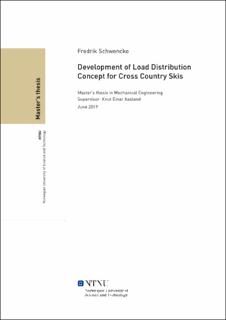| dc.contributor.advisor | Aasland, Knut Einar | |
| dc.contributor.author | Schwencke, Fredrik | |
| dc.date.accessioned | 2019-11-10T15:00:39Z | |
| dc.date.issued | 2019 | |
| dc.identifier | no.ntnu:inspera:46065051:35443911 | |
| dc.identifier.uri | http://hdl.handle.net/11250/2627533 | |
| dc.description.abstract | Å tilstrebe best mulige ski er kritisk for langrennsløpere hvis man skal ha mulighet til å kjempe om de gjeveste medaljene i de olymipske leker, verdemsmesterskap, eller andre store skirenn. Gjennom de siste tiårene har måling av skiegenskaper blitt stadig viktigere. I dag er det i all hovedsak Olympiatoppen som står for måling av ski og teknologiutvikling for det norske landslaget. Olympiatoppen bruker trykkmatter til å måle trykkfordeling mot underlaget, noe de anser som tidkrevende og kostbar teknologi dersom målenøyaktigheten skal være tilfredsstillende.
Trykkfordeling er viktig for skiens ytelse fordi den påvirker friksjonen mellom snøen og sålen til skien. Målet med denne masteroppgaven er derfor å utvikle et konsept som enklere og mer nøyaktig måler trykkfordeling over skiens lengderetning. Konseptet som er utviklet baserer seg på en lastsensor som føres under skien i skiens lengderetning mens skien er lastet med en bestemt punktlast i området rundt bindingen.
Konseptet som er utviklet baserer seg på at lastsensoren hever skien fra underlaget for at den skal kunne lese av lasten. Dette gjør at lasten blir mer konsentrert på lastsensoren. Ved bruk av trykkmatter derimot, ligger hele skiens kontaktflate fordelt naturlig på trykkmattene, noe som gjør at det måles lavere trykk enn for konseptet. En annen forskjell er at konseptet er avhengig av å bruke en fjær i lastmekanismen for å holde den påførte lasten stabil. For trykkmattene brukes det en statisk last fordi skien ikke må heves.
Testresultater fra konseptet viser sammenhengende lastkurver med ett topppunkt på fremski og ett på bakski, i motsetning til trykkmattene som viser flere topp- og bunnpunkter. Det er klare likhetstrekk mellom trykkmattene og konseptet med tanke på lokasjonen av det høyeste trykket og hvordan dette trykket beveger seg med økende last.
Resultatene viser at konseptet har potensiale til videreutvikling da tidsbruk og nøyaktighet vil kunne forbedres i forhold til Olympiatoppens trykkmatter. Siden resultatene ikke kan sammenlignes direkte med resultatene fra trykkmattene er det nødvendig å etablere en base med målinger for å finne potensielle sammenhenger mellom snøforhold og ski. Ytterligere testing er derfor avgjørende, men det er forventetet at teknologien kan bistå til å bedre forståelsen av skiens trykkfordelingsegenskaper. | |
| dc.description.abstract | Having top performing skis is critical for a world class cross country skier to be able to fight for the medals in the Olympics, World Championships and other major races. Throughout the last decade, measuring ski properties has become increasingly important. Today, the Norwegian Olympic Foundation is in charge of measuring skis and technology development for the Norwegian national team. The Norwegian Olympic Foundation use pressure mats to measure pressure distribution, which is considered time consuming and costly if the accuracy of the measurements are to be satisfying.
Pressure distribution is important for a skis performance as it has great influence on the friction between the snow and the base of the ski. The aim of this thesis is, therefore, to develop a concept that simplifies and more accurately measures pressure distribution over the length of the ski. The concept developed relies on a load sensor sliding under the length of the ski while the ski is loaded with a set point load in the area around the binding.
The concept developed is based on the load sensor elevating the ski from the surface to get a proper reading. This results in a more concentrated load on the load sensor. With the use of pressure mats, on the other hand, the full contact area of the ski is naturally distributed on the pressure mats, which results in lower pressure compared to the concept developed. Another difference is that the developed concept is dependant on a spring in the loading mechanism to keep the applied load stable. For the pressure mats, a static load is used as no elevation of the ski is necessary.
Test results shows continuous load curves with one peak on the front end and one peak on the back end of the ski. The pressure mats, on the other hand, show several peaks and lows on both ends of the ski. There are clear similarities between the developed concept and the pressure mats when it comes to the location of the peak pressure and how these peaks move with increasing applied load.
The results from the thesis show that the concept has potential for further development as time usage and resolution can be improved compared to the pressure mats used by the Norwegian Olympic Foundation. Since the results cannot be directly compared to the results from the pressure mats, it is necessary to establish a base of measurements to find potential relationships between snow conditions and skis. Further testing is crucial, but it is expected that the concept can contribute to improved understanding of the pressure distribution of a ski. | |
| dc.language | eng | |
| dc.publisher | NTNU | |
| dc.title | Development of Load Distribution Concept for Cross Country Skis | |
| dc.type | Master thesis | |
